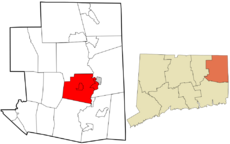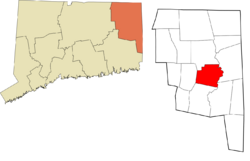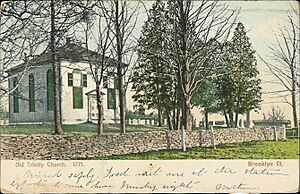Brooklyn, Connecticut facts for kids
Quick facts for kids
Brooklyn, Connecticut
|
||
|---|---|---|

Brooklyn town hall
|
||
|
||
 Windham County and Connecticut Windham County and Connecticut |
||
| Country | ||
| U.S. state | ||
| County | Windham | |
| Region | Northeastern CT | |
| Incorporated | 1786 | |
| Government | ||
| • Type | Selectman-town meeting | |
| Area | ||
| • Total | 29.1 sq mi (75.4 km2) | |
| • Land | 29.0 sq mi (75.0 km2) | |
| • Water | 0.2 sq mi (0.4 km2) | |
| Elevation | 210 ft (64 m) | |
| Population
(2020)
|
||
| • Total | 8,450 | |
| • Density | 291.4/sq mi (112.7/km2) | |
| Time zone | UTC-5 (EST) | |
| • Summer (DST) | UTC-4 (EDT) | |
| ZIP code |
06234, 06239
|
|
| Area code(s) | 860/959 | |
| FIPS code | 09-09190 | |
| GNIS feature ID | 0213400 | |
Brooklyn is a town in Windham County, Connecticut, United States. It is part of the Northeastern Connecticut Planning Region. In 2020, about 8,450 people lived in Brooklyn. The main part of town, known as Brooklyn Center, and another area called East Brooklyn, are both recognized as important places by the U.S. Census Bureau.
Contents
About Brooklyn's Location
Brooklyn covers a total area of about 29.1 square miles (75.4 square kilometers). Most of this area, about 29.0 square miles (75.0 square kilometers), is land. A small part, about 0.2 square miles (0.4 square kilometers), is water.
Brooklyn's History
Brooklyn was first settled in the late 1600s. It officially became its own town in 1786. The town gets its name from the Quinebaug River, which was once called the "Brook Line." This river forms the eastern border of the town.
Brooklyn is home to the Brooklyn Fair, which is the oldest continuously running agricultural fair in America. This means it has been happening every year for a very long time! The town also has a state-run correctional facility.
In 1833, an important event happened in Brooklyn. A schoolteacher named Prudence Crandall had a trial here. She was charged because she opened a school for African American girls in nearby Canterbury. Her trial was a big moment in the fight for equal education.
Brooklyn is also the final resting place of Israel Putnam, a famous general from the Revolutionary War. He was first buried in a tomb, but because so many people visited, his remains were moved. In 1888, a statue of General Putnam on a horse was built. His sarcophagus (a stone coffin) was placed inside the statue's foundation. You can find this statue near the town green, in front of the post office.
The town has its own historical society, which runs the Brooklyn Historical Society Museum. This museum includes the Daniel Putnam Tyler Law Office, showing what a law office looked like long ago.
Town Villages and Areas
Brooklyn is made up of several smaller communities, or villages. These include:
- Allen Hill
- Barrett Hill
- Brooklyn Center
- Bush Hill
- East Brooklyn
- Quebec
- Stetson's Corners
- Tatnic Hill
- West Village
- West Wauregan
Historic Places in Brooklyn
Several places in Brooklyn are listed on the National Register of Historic Places. This means they are important historical sites that are protected. Some of these include:
- Brooklyn Green Historic District
- Bush Hill Historic District
- Putnam Farm
- Trinity Church
- Unitarian Meetinghouse
- Quinebaug Mill-Quebec Square Historic District
Education in Brooklyn
Students in Brooklyn are served by the Brooklyn School District. Younger students attend Brooklyn Elementary School (Kindergarten to 4th grade) and Brooklyn Middle School (5th to 8th grade).
For high school, many students from Brooklyn go to Woodstock Academy. Woodstock Academy has been one of Brooklyn's designated high schools since 1987. Some students also attend Killingly High School in Danielson, or other schools like H.H. Ellis Technical High School or the Norwich Free Academy.
Brooklyn's Population
| Historical population | |||
|---|---|---|---|
| Census | Pop. | %± | |
| 1820 | 1,254 | — | |
| 1850 | 1,514 | — | |
| 1860 | 2,136 | 41.1% | |
| 1870 | 2,354 | 10.2% | |
| 1880 | 2,308 | −2.0% | |
| 1890 | 2,628 | 13.9% | |
| 1900 | 2,358 | −10.3% | |
| 1910 | 1,858 | −21.2% | |
| 1920 | 1,655 | −10.9% | |
| 1930 | 2,250 | 36.0% | |
| 1940 | 2,403 | 6.8% | |
| 1950 | 2,652 | 10.4% | |
| 1960 | 3,312 | 24.9% | |
| 1970 | 4,965 | 49.9% | |
| 1980 | 5,691 | 14.6% | |
| 1990 | 6,681 | 17.4% | |
| 2000 | 7,173 | 7.4% | |
| 2010 | 8,210 | 14.5% | |
| 2020 | 8,450 | 2.9% | |
| U.S. Decennial Census | |||
Brooklyn's population has grown steadily over the years. In 2010, there were 8,244 people living in the town. These people lived in about 3,001 households.
The population includes people from many different backgrounds. In 2010, most residents were White, with smaller groups of African American, Native American, and Asian people. About 4% of the population identified as Hispanic or Latino.
The average age in Brooklyn in 2010 was about 40.9 years old. About 24% of the population was under 20 years old.
Notable People from Brooklyn
Many interesting people have connections to Brooklyn:
- David Low Dodge was born here. He managed Connecticut's first cotton factory and helped start important societies like the New York Bible Society.
- Waldo Hutchins was a U.S. Representative from New York.
- Samuel J. May was a minister who supported Prudence Crandall's school for African American girls.
- Elijah Paine (1757–1842) was a U.S. senator from Vermont.
- Adelaide Ward Peckham (1848–1944), a bacteriologist, was born in town.
- Israel Putnam, a general in the Revolutionary War, lived and died in Brooklyn.
- John Day Putnam was a Democratic member of the Wisconsin State Assembly.
Brooklyn's Climate
Brooklyn has a climate where the temperatures don't change too much between highs and lows. It also gets enough rain throughout the year. This type of climate is known as a marine west coast climate.
See also
 In Spanish: Brooklyn (Connecticut) para niños
In Spanish: Brooklyn (Connecticut) para niños




